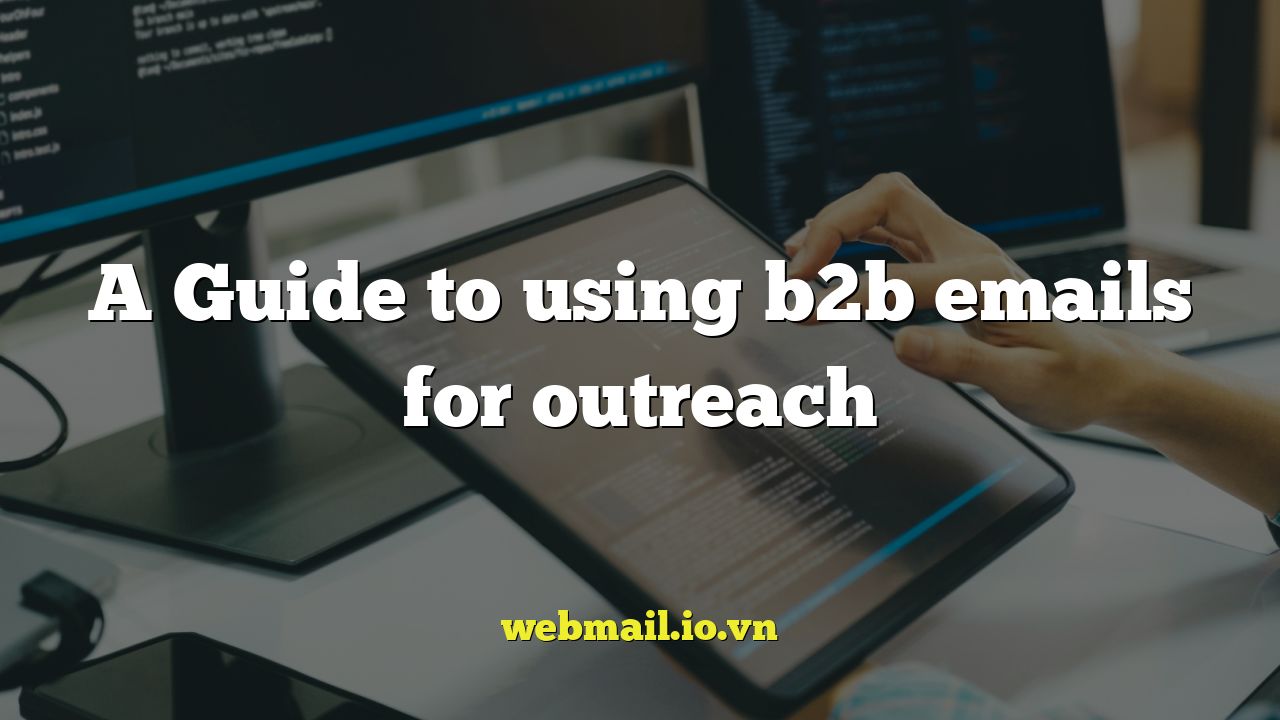
A Guide to Using B2B Emails for Outreach
In the competitive landscape of business-to-business (B2B) interactions, email outreach remains a cornerstone of effective communication. However, crafting emails that cut through the noise and generate meaningful engagement requires a strategic approach. This guide provides a comprehensive overview of how to leverage B2B emails for successful outreach, covering everything from identifying your target audience to measuring your campaign’s performance.
Understanding the B2B Email Landscape
B2B email outreach differs significantly from B2C. B2B communications often involve more complex sales cycles, multiple decision-makers, and a greater emphasis on building trust and establishing long-term relationships. Before launching your campaign, it’s crucial to understand the nuances of this landscape.
Key Differences Between B2B and B2C Email Marketing
- Focus: B2B emphasizes problem-solving and value proposition, while B2C often focuses on emotional appeal and immediate gratification.
- Audience: B2B targets professionals with specific needs and business goals, while B2C targets individual consumers with diverse interests.
- Sales Cycle: B2B involves longer sales cycles and multiple touchpoints, while B2C often aims for quick conversions.
Defining Your Target Audience
The foundation of any successful B2B email outreach campaign is a clear understanding of your target audience. This involves identifying the specific industries, companies, and roles that align with your product or service. Thorough research is essential to tailor your messaging effectively.
Steps to Define Your Target Audience
- Identify Ideal Customer Profiles (ICPs): Create detailed profiles of your ideal customers, including their industry, company size, revenue, and key challenges.
- Segment Your Audience: Divide your target audience into smaller, more manageable segments based on shared characteristics and needs.
- Research Key Decision-Makers: Identify the individuals within your target companies who have the authority to make purchasing decisions.
Crafting Compelling Email Content
Once you have a clear understanding of your target audience, you can begin crafting compelling email content that resonates with their specific needs and interests. Your emails should be clear, concise, and focused on providing value to the recipient.
Essential Elements of Effective B2B Emails
- Subject Line: Create a subject line that grabs attention and clearly communicates the value of your email. Avoid generic or salesy language.
- Personalization: Personalize your emails by addressing the recipient by name, referencing their company, and tailoring your message to their specific needs.
- Value Proposition: Clearly articulate the value that your product or service offers and how it can help the recipient solve their business challenges.
- Call to Action (CTA): Include a clear and concise CTA that encourages the recipient to take the next step, such as visiting your website, scheduling a demo, or downloading a resource.
Best Practices for Email Content
- Keep it Concise: Respect the recipient’s time by keeping your emails short and to the point.
- Focus on Benefits: Highlight the benefits of your product or service rather than just listing its features.
- Use a Conversational Tone: Write in a friendly and approachable tone that encourages engagement.
- Proofread Carefully: Ensure that your emails are free of grammatical errors and typos.
Optimizing Your Email Outreach Campaign
To maximize the effectiveness of your B2B email outreach campaign, it’s crucial to optimize various aspects of your strategy, including your email deliverability, send times, and subject lines.
Improving Email Deliverability
Ensuring that your emails reach the intended recipients’ inboxes is paramount. Poor deliverability can significantly hinder your outreach efforts. Several factors influence deliverability, including your sender reputation, email authentication, and content.
Optimizing Send Times
The time of day you send your emails can significantly impact open rates and engagement. Research suggests that Tuesdays, Wednesdays, and Thursdays generally yield the best results. However, it’s essential to test different send times to determine what works best for your target audience.
A/B Testing Subject Lines
Subject lines play a crucial role in determining whether recipients open your emails. A/B testing allows you to experiment with different subject lines to identify which ones generate the highest open rates. Test various factors, such as length, personalization, and value proposition.
Leveraging Email Automation Tools
Email automation tools can streamline your B2B email outreach efforts, allowing you to send personalized emails at scale, track engagement metrics, and automate follow-up sequences. These tools can significantly improve efficiency and productivity.
Popular Email Automation Platforms
Several email automation platforms cater specifically to B2B marketers. Some popular options include:
- HubSpot: A comprehensive marketing automation platform that offers a wide range of features, including email marketing, CRM, and lead nurturing.
- Mailchimp: A user-friendly email marketing platform that offers a variety of templates, automation tools, and analytics.
- Salesforce Marketing Cloud: A powerful marketing automation platform designed for enterprise-level organizations.
Measuring and Analyzing Campaign Performance
To determine the success of your B2B email outreach campaign, it’s essential to track key metrics and analyze your results. This data will provide valuable insights into what’s working and what’s not, allowing you to refine your strategy and improve your future campaigns.
Key Metrics to Track
- Open Rate: The percentage of recipients who opened your email.
- Click-Through Rate (CTR): The percentage of recipients who clicked on a link in your email.
- Conversion Rate: The percentage of recipients who completed a desired action, such as filling out a form or making a purchase.
- Bounce Rate: The percentage of emails that could not be delivered.
- Unsubscribe Rate: The percentage of recipients who unsubscribed from your email list.
By consistently monitoring these metrics and making data-driven adjustments, you can optimize your B2B email outreach campaign for maximum impact.